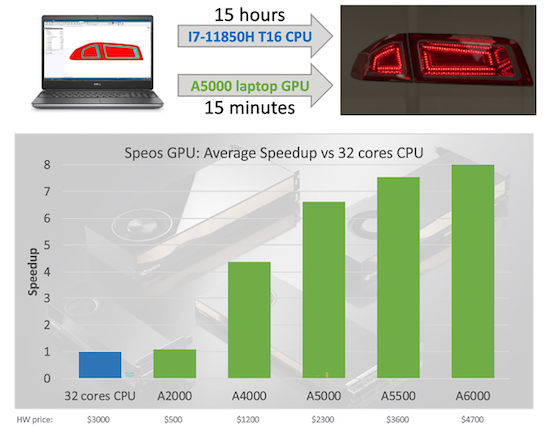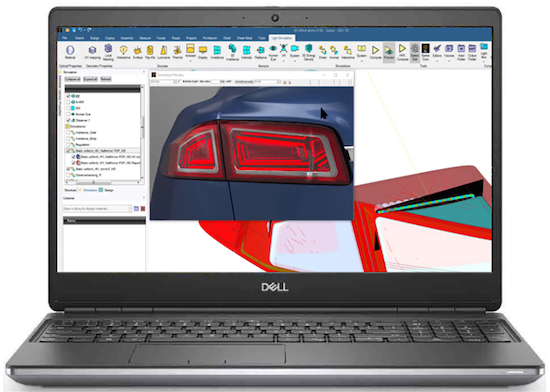Seeing the Light in Simulation
NVIDIA RTX technology powers advanced ray tracing and optical simulation.

The false color pictures shows the luminance, the actual amount of energy that reaches the eye. This allows to quantify the homogeneity of an illumination system, check the luminosity of a display, or compare amounts of unwanted reflections in the windshield. Image courtesy of Ansys.
Engineering Resource Center News
Engineering Resource Center Resources


Dell

Latest News
December 14, 2022
Simulating the performance and behavior of light in engineering is a complex process. Whether you are evaluating the performance of a functional light (like a headlight) under operating conditions or trying to visualize how ambient light will affect the appearance or ease-of-use of a new design (such as the interior of an aircraft), these simulations are compute intensive and complex.
But this type of ray tracing is critical, particularly as optics play a larger and larger role both in aesthetics and in the performance of sensor-dependent systems like autonomous robots and vehicles. Accurate simulation and visualization of ray activity can improve optics performance and reduce the need for expensive physical prototyping and testing.
Computational constraints have typically been the bottleneck when it comes to performing the time-consuming calculations required for ray tracing. GPU acceleration has helped organizations boost performance by providing more compute power at the workstation level – Ansys Speos is a good example of a solution that has leveraged NVIDIA RTX™ technology to accelerate optical simulation performance.
Thanks to GPU-enabled real-time ray tracing, engineers can evaluate how their designs will look and function in a variety of lighting conditions without having to wait on lengthy computational processes or exporting CAD models into different rendering platforms. This has helped reduce the need for physical prototypes as well.

Speos has traditionally leveraged high-performance computing (HPC) clusters to speed up computations, but both on-premise and cloud-based HPC solutions present cost and maintenance hurdles for many companies. Thanks to advancements in the NVIDIA RTX platform that have been embraced by Ansys over the past several years (including ray tracing acceleration via NVIDIA OptiX™), Speos can now provide accelerated ray tracing and accurate results more affordably and accessibly.
According to Ansys testing on a single laptop, Speos was able to complete a simulation that previously took 15 hours on the CPU in just 15 minutes using an NVIDIA RTX™ A5000 GPU, or a 60x improvement. With two GPUs, the performance doubled to 120x.

By leveraging NVIDIA RTX, Ansys Speos can deliver full physical ray tracing to depict accurate reflection and glare levels during design and in virtual product reviews.
In addition, Speos Live Preview functionality leverages GPU acceleration to provide real-time simulations of optical designs so that engineers can test changes quickly and interactively during their normal workflow. Live Preview is optimized to run on NVIDIA RTX GPUs.
For HPC users, NVIDIA RTX GPUs can provide additional benefits for Speos. Using GPU-side calculations in conjunction with HPC resources, engineering organizations can experience linear scalability. Speos HPC-GPU provides faster simulation performance by expanding GPU acceleration across an HPC cluster. The latest release supports multi-GPU and multi-node deployment, so users can enable multiple GPUs on each node, providing even faster performance.
Customers have taken advantage of these capabilities in a number of ways. Safran Aerosystems, which designs lighting and signaling systems for aircraft manufacturers, has used Speos to model and validate virtual prototypes of interior and exterior lighting and signaling systems. This replaced the difficult and expensive process of validating designs in live runway testing.
Mazda Corp. used Speos to help develop the interiors and lights on its MAZDA3 vehicle. Previously, verifying lighting performance was done with physical testing on an actual vehicle. With Speos, Mazda was able to evaluate legal and regulatory luminous intensity requirements, as well as overall aesthetic performance of the lighting systems, much earlier in the development process. This has reduced the need for physical prototyping, and improved engineers ability to identify design problems like light leak much more effectively.
You can learn more about GPU-enabled Speos enhancements in this webinar.
More Dell Coverage

More NVIDIA Coverage
Subscribe to our FREE magazine, FREE email newsletters or both!
Latest News





